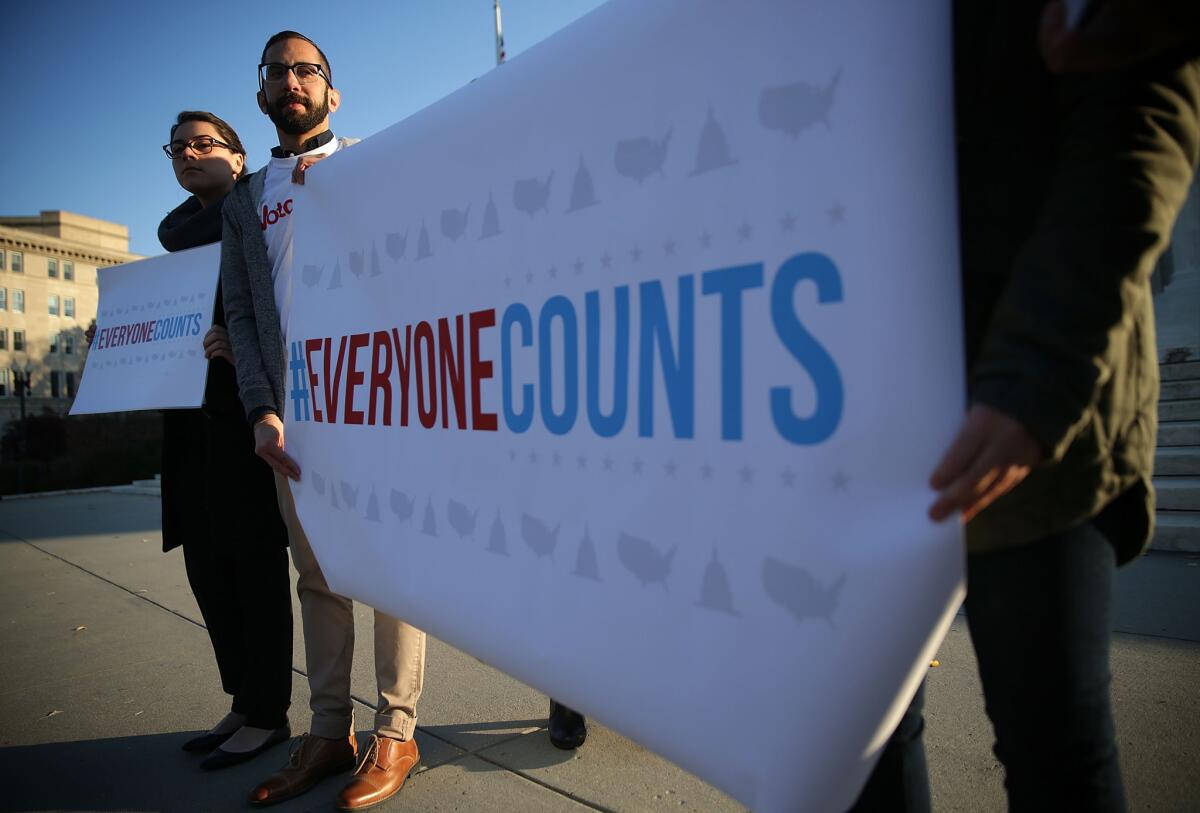Supreme Court appears ready to shake up how election districts are drawn

Activists hold signs during a news conference in front of the Supreme Court December 8, 2015 in Washington, DC.
- Share via
Reporting from Washington — The Supreme Court sounded poised Tuesday to order a significant shift in how political power is allocated in this country, one that could give more clout to rural and mostly Republican areas at the expense of Democratic-dominated cities.
The justices heard arguments in a Texas case that could force all 50 states to change the way they draw election districts for members of the House of Representatives, state legislatures, city councils and other local bodies.
At issue before the court was the basic question of who gets counted when election districts are drawn: Is it all people, including children, prisoners and immigrants who are not eligible to vote? Or is it only adult citizens who are eligible voters?
SIGN UP for the free Essential Politics newsletter >>
Throughout American history and in all 50 states, election districts have been drawn based on data from the U.S. Census, which counts all people who live in the area.
But the growing Latino population, particularly in states such as California, Texas and Florida, includes large numbers of people who are not citizens and cannot vote. That means in those states, election districts created to have equal numbers of people may not also have equal numbers of voters.
In the case heard Tuesday, two Texas Republicans who live in rural districts say they are denied the “equal protection of the laws” because the state’s election districts undercount the votes of U.S. citizens and overcount those who live in districts with large numbers of immigrants.
Their lawyers said the court should clarify its “one person, one vote” rule, set in the 1960s, and tell states they should give “equal weight to equal numbers of voters.”
The court’s conservatives, including Justice Anthony M. Kennedy, appeared to agree with the challengers.
“It’s called the one person-one vote rule. That seems to be designed to protect voters,” said Chief Justice John G. Roberts Jr.
Kennedy said he did not understand how Texas could justify the “huge disparity” that results from greatly different numbers of actual voters in state Senate districts.
The challengers cited the example of two Texas state Senate districts, both of which have about 800,000 residents. One rural district in east Texas, where plaintiff Sue Evenwel resides, had about 574,000 citizens who are eligible to vote; the other district in the Rio Grande valley had only 372,000 people who are eligible to vote. The lawsuit in Evenwel vs. Abbott argues this is unconstitutional.
Disagreeing, an Obama administration lawyer argued the Constitution has been understood to require “equal representation for equal numbers of people.”
But Justice Samuel A. Alito Jr. wondered whether election districts must count prisoners and noncitizens. “Does this include all these groups, including undocumented aliens?” he asked.
Deputy Solicitor Gen. Ian Gershengorn replied that districts have always been drawn based on their “total population,” and include children who cannot vote. He cited the difference between Manhattan, where 9% of residents are children, and Brooklyn, where 30% are children. If the court required election districts to be drawn based on the number of eligible voters, Brooklyn would lose representation while Manhattan would gain.
A Texas state lawyer also urged the court to stick with the current system. Otherwise, all 50 states will have to redraw their election districts. Critics also note that accurate figures for eligible voters are difficult to obtain.
But only the court’s liberal justices indicated they agreed.
While Tuesday’s argument went well for the conservative challengers, both Roberts and Kennedy suggested the court might hand down a limited ruling that would force states to make changes only in districts where large numbers of people are not eligible voters. A lawyer told the court the impact of such a rule would fall heaviest on states such as California, New York and Texas.
And rather than order a sweeping and immediate overhaul of voting districts, Kennedy and Roberts signaled the court could put states on notice that future election districts must have roughly equal numbers of eligible voters. Such a decision would not require states to make immediate changes, but rather warn them they must apply this rule when they redraw districts after the 2020 census.
Lawyers for Los Angeles, Chicago and a half dozen other major cities filed a brief urging the court to reject the challenger’s claim.
“It’s a bedrock principle of our democracy -- equal representation for equal numbers of people,” said Harit Trivedi, a Los Angeles assistant city attorney. A change, he said, “would affect all of the residents of urban areas, not just citizens and voters” because it could mean less representation for those areas and therefore less government funding and assistance from Sacramento and Washington.
It will be several months before the justices issue a decision.
The lawsuit heard Tuesday was launched and funded by Edward Blum, a conservative investor from Texas who has opposed race-based college admissions and race-based election districts. On Wednesday, the court will hear a challenge to the affirmative action policy at the University of Texas, which began with a lawsuit funded by Blum.
Two years ago, the high court struck down part of the Voting Rights Act in an Alabama case that was also launched by Blum.
On Twitter: @DavidGSavage
ALSO
San Bernardino shooters ‘radicalized,’ but did they get help?
Republicans condemn Trump but won’t rule out backing him if he becomes the nominee
California billionaire Tom Steyer has rare access and a big megaphone on climate change
More to Read
Sign up for Essential California
The most important California stories and recommendations in your inbox every morning.
You may occasionally receive promotional content from the Los Angeles Times.














